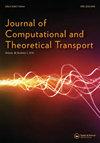Three-Dimensional Numerical Study of a Fluid-Kinetic Model for Respiratory Aerosols with Variable Size and Temperature
IF 1.1
4区 工程技术
Q3 MATHEMATICS, APPLIED
Journal of Computational and Theoretical Transport
Pub Date : 2021-04-05
DOI:10.1080/23324309.2021.1906705
引用次数: 0
Abstract
Abstract In this paper, we extend to the three-dimensional case the numerical study previously performed in a two-dimensional framework for a complex coupled fluid-kinetic model describing respiratory aerosols. The specificity of this model lies in the fact that it takes into account the airway humidity and the resulting hygroscopic effects on the aerosol droplets, namely their size variation. The air is described through a system of partial differential equations: the incompressible Navier–Stokes equations for the air velocity, convection-diffusion equations on its temperature, and water vapor mass fraction. The aerosol distribution function obeys a Vlasov-type equation and depends on the standard kinetic variables, but also on radius and temperature variables. After discussing again the implementation strategy, we perform numerical experiments, mainly in a branched structure looking like the trachea and the first lung generation. This allows the presentation of various statistics on the aerosol behavior in terms of particle deposition, temperature, and size variation of the droplets. We observe that the outcome appears coherent with the two-dimensional case. Finally, we discuss several assumptions which may lead to model simplifications, such as the fact that the water vapor mass fraction in the air may be considered to be constant throughout the branched structure in standard breathing conditions.变粒径变温度呼吸性气溶胶流体动力学模型的三维数值研究
摘要在本文中,我们将先前在二维框架中对描述呼吸气溶胶的复杂耦合流体动力学模型进行的数值研究扩展到三维情况。该模型的特殊性在于,它考虑了气道湿度和由此产生的气溶胶液滴吸湿效应,即其大小变化。空气是通过一个偏微分方程系统来描述的:空气速度的不可压缩Navier-Stokes方程、温度的对流-扩散方程和水蒸气质量分数。气溶胶分布函数服从Vlasov型方程,取决于标准动力学变量,也取决于半径和温度变量。在再次讨论了实现策略后,我们进行了数值实验,主要是在看起来像气管和第一代肺的分支结构中。这使得能够在颗粒沉积、温度和液滴尺寸变化方面呈现关于气溶胶行为的各种统计数据。我们观察到,结果似乎与二维情况一致。最后,我们讨论了可能导致模型简化的几个假设,例如在标准呼吸条件下,空气中的水蒸气质量分数可以被认为在整个分支结构中是恒定的。
本文章由计算机程序翻译,如有差异,请以英文原文为准。
求助全文
约1分钟内获得全文
求助全文
来源期刊

Journal of Computational and Theoretical Transport
Mathematics-Mathematical Physics
CiteScore
1.30
自引率
0.00%
发文量
15
期刊介绍:
Emphasizing computational methods and theoretical studies, this unique journal invites articles on neutral-particle transport, kinetic theory, radiative transfer, charged-particle transport, and macroscopic transport phenomena. In addition, the journal encourages articles on uncertainty quantification related to these fields. Offering a range of information and research methodologies unavailable elsewhere, Journal of Computational and Theoretical Transport brings together closely related mathematical concepts and techniques to encourage a productive, interdisciplinary exchange of ideas.
 求助内容:
求助内容: 应助结果提醒方式:
应助结果提醒方式:


